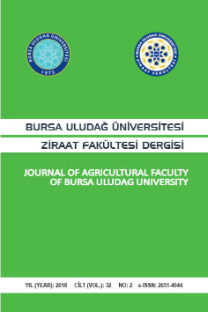A morphometric study on the uropygial gland of the male and female checks given diets containing red hot pepper
civciv, morfometri, kümes hayvanları, cinsiyet farklılıkları, deri bezleri, Capsicum
Erkek ve dişi civcivlerde kırmızı acı biberli rasyonla beslenmenini glandula uropygialis' in morfometrisi üzerine etkisinin incelenmesi
chicks, morphometrics, poultry, sex differences, skin glands, Capsicum,
___
1. Baumel, J.J., King, A.S., Lucas, A.M., Breazile, J.L., Evans, H.E. Nomina Anatomica Avium, Academic Press London, New York, Toronto, Sydney, San Francisko, 1979. 21-42. 2. Blackwell, H.W. Poisonous and Medicinal Plants, Prentice Hall Inc., 1990; 171. 3. Frohne, D., Pfander, H.J. A Color Atlas of Poisonous Plants, Wolfe Publishing LTD, 1983. 4. Furuse, M., Nakajima, S., Miyagawa, S., Nakagawa, J., Okumura, J. Feeding behaviour, abdominal fat and laying performance in laying hens given diets containing red pepper. Jpn. Poult. Sci. 1994; 31 (1) 45-52. 5. Geisthovel, E. Die Wirkung des Capsaicins auf die Temperaturregulation der Vogel, untersucht am Beispiel der Peking-Ente (Anas platyrhynchos). Thesis. 1985; 90. Giessen. 6. Grau, H. Anatomie der Hausvögel. ״Ellenberger Baum’un Handbuch der Anatomie der Haustiere ״ (O.E. Zietschmann, E. Ackerknecht und H. Grau, eds.) 18. Auflage, Springer Verlag, Berlin. 1943. 7. Jang, J.J., Devor, D.E., Longsdon, D.L., Ward, J.M. A 4- Week feeding study of ground red chilli (Capsicum annuum) in male B6C3f1 Mice. Fd. Chem. Toxic. 1992; 30 (9) 783-787. 8. John, A.T., Abraham, S. Cytological abnormalites induced by red pepper in mouse bone marrow cells in vivo. Caryologia. 1994; 47 (1) 53-58. 9. Kawada, T., Hagihara, K., Iwai, K. Effects of capsaicin on lipid metabolism in rats fed a high fat diet. J. Nutr. 1986; 116, 1272-1278. 10. Matsuo, T., Yoshioka, M., Suzuki, M. Capsaicin in diet does not affect glycogen contents in the liver and skeletal muscle of rats before and after exercise. J. of Nutr. Sci. and Vitaminol. 1996; 42 (32) 249-256. 11. McElroy, A.P., Manning, J.G., Jaeger, L.A., Taub, M., Williams, J.D., Hargis, B.M. Effect of prolonged administration of dietary capsaicin on broiler growth and Salmonella enteridis susceptibility. Avian Diseases. 1994; 38 (2) 329-333. 12. Nopanitaya, W. Long term effects of capsaicin on fat absorption and the growth of the rat. Toxico. and App. Pharm. 1973; 37, 269-279. 13. Schummer, A. Anatomie der Hausvögel, Lehrbuch der Anatomie der Haustiere, Nickel, R., Schummer, A., Seiferle, E., Paul Parey In Berlin und Hamburg, Band V, 1973, 158. 14. Schwarze, E., Schröder, L. Kompendium der Geflügel Anatomie. Gustav Fisher Verlag, Stuttgart, New York, 1979. 15. Srinivasan, M.R., Satyanarayana, M.N. Effect of capsaicin on skeletal muscle lipoprotein lipase in rats fed high fat diet. Indian Journal of Experimental Biology. 1989; 27 (10) 910-912. 16. Tellez, G.I., Jaeger, L., Dean, C.E., Corrier,D.E., Deloach, J.R., Williams, J.D., Hargis, B.M. Effects of prolonged administration of dietary capsaicin salmonella enteridis infection in Legorn chicks. Avian Diseases. 1993; 37(1) 143-148. 17. Traurig, H.H., Papka, R.E., Saria, A., Lembeck, F. Substance P immunoreactivity (SP-I) in lactating rat nipples and the effects of neonatal capsaicin treatment on subsequent. Anat. Rec. 1984; 208 (3): 185A. 18. Weyrich, M. Der Einfluss von Capsaicin auf die Membranstrome sensorischer Kukenneurone. Thesis. 1987; 92. Giessen.- ISSN: 1301-3173
- Yayın Aralığı: 2
- Başlangıç: 1981
- Yayıncı: Ahmet Akkoç
Cryptosporidium parvum' un buluşmasında su ve gıdaların rolü
Tavuk ve horozların gelişme sürecinde hipofiz bezi pars distalisinin histolojik yönden incelenmesi
Effect of glass wool filtration method on frozen-thawed dog semen
Ülgen GÜNAY, ZEKARİYA NUR, M. Kemal SOYLU
Some fattening and slaughter characteristics of Holstein young bulls in intensive conditions
ÖMÜR KOÇAK, Bülent EKİZ, Alper YILMAZ, Halil GÜNEŞ
Tam yağlı soyanın metabolik enerji değerinin broyler performansından tahmini
Nizamettin Şenköylü, Hasan AKYÜREK, H. Ersin ŞAMLI, AYLİN AĞMA OKUR
Levels of zinc, copper and magnesium in sheep with toxoplasmosis
Kamil SEYREK, SERDAR PAŞA, FUNDA KIRAL, AYŞEGÜL BİLDİK, Babür CAHİT, Selçuk KILIÇ
METİN PETEK, Ş.Şule GEZEN, FAZLI ALPAY
